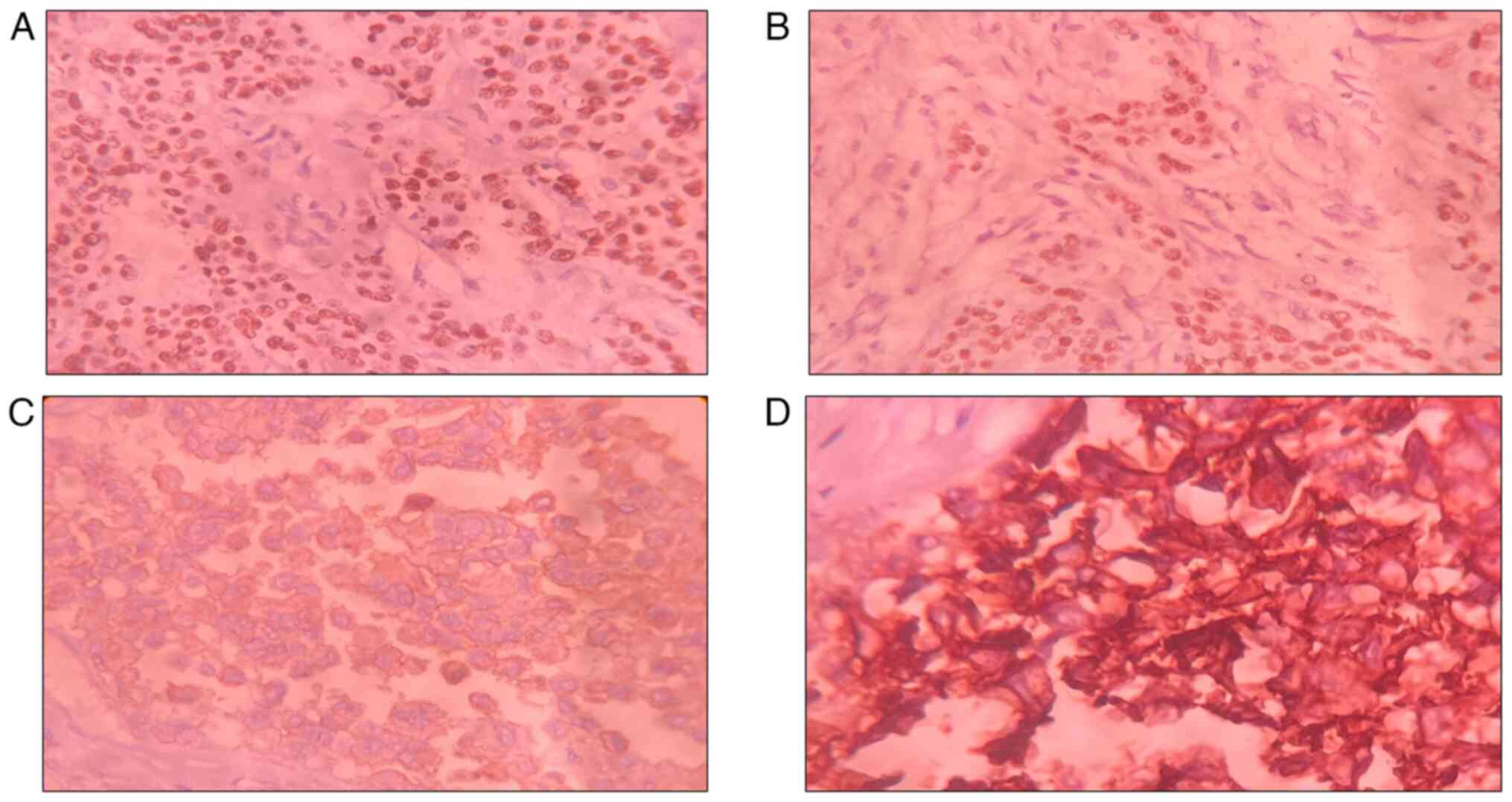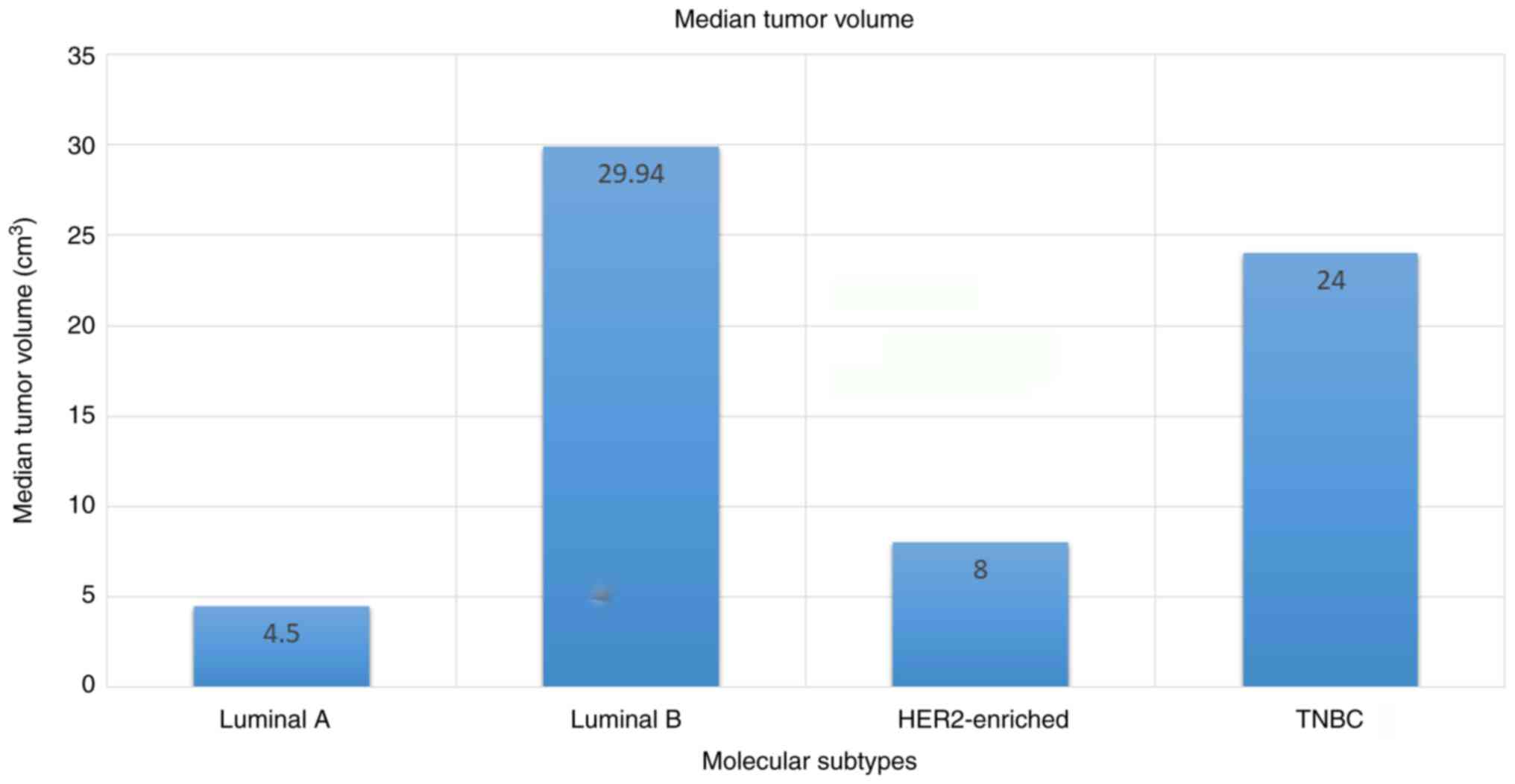|
1
|
Sung H, Rosenberg PS, Chen WQ, Hartman M,
Lim WY, Chia KS, Wai-Kong Mang O, Chiang CJ, Kang D, Ngan RK, et
al: Female breast cancer incidence among Asian and Western
populations: More similar than expected. J Natl Cancer Inst.
107(djv107)2015.PubMed/NCBI View Article : Google Scholar
|
|
2
|
Sung H, Ferlay J, Siegel RL, Laversanne M,
Soerjomataram I, Jemal A and Bray F: Global Cancer Statistics 2020:
GLOBOCAN estimates of incidence and mortality worldwide for 36
cancers in 185 countries. CA Cancer J Clin. 71:209–249.
2021.PubMed/NCBI View Article : Google Scholar
|
|
3
|
Youlden DR, Cramb SM, Yip CH and Baade PD:
Incidence and mortality of female breast cancer in the Asia-Pacific
region. Cancer Biol Med. 11:101–115. 2014.PubMed/NCBI View Article : Google Scholar
|
|
4
|
Ferlay J, Soerjomataram I, Dikshit R, Eser
S, Mathers C, Rebelo M, Parkin DM, Forman D and Bray F: Cancer
incidence and mortality worldwide: sources, methods and major
patterns in GLOBOCAN 2012. Int J Cancer. 136:E359–E386.
2015.PubMed/NCBI View Article : Google Scholar
|
|
5
|
Rangarajan B, Shet T, Wadasadawala T, Nair
NS, Sairam RM, Hingmire SS and Bajpai J: Breast cancer: An overview
of published Indian data. South Asian J Cancer. 5:86–92.
2016.PubMed/NCBI View Article : Google Scholar
|
|
6
|
Gupta P, Rai NN, Agarwal L and Namdev S:
Comparison of molecular subtypes of carcinoma of the breast in two
different age groups: A single institution experience. Cureus.
10(e2834)2018.PubMed/NCBI View Article : Google Scholar
|
|
7
|
Sharma JD, Khanna S, Ramchandani S, Kakoti
LM, Baruah A and Mamidala V: Prevalence of molecular subtypes of
breast carcinoma and its comparison between two different age
groups: A retrospective study from a tertiary care center of
northeast India. South Asian J Cancer. 10:220–224. 2021.PubMed/NCBI View Article : Google Scholar
|
|
8
|
Jain S, Narang V, Jain K, Paul D, Singh J,
Sohi AS, Sood S, Aggarwal R, Sood N and Brar GS: Prevalence of
molecular subtypes in operated cases of breast cancer and its
clinicopathological correlation: A single institute study from a
tertiary cancer centre in North India. Indian J Surg Oncol.
12:538–544. 2021.PubMed/NCBI View Article : Google Scholar
|
|
9
|
Pereira C, Martis M, D'Souza R and Tauro
LF: Correlation of clinicopathological features of breast cancer
with molecular subtypes taking Ki-67 into Consideration: Single
institution experience over 5 years. Curr Health Sci J. 47:348–352.
2021.PubMed/NCBI View Article : Google Scholar
|
|
10
|
Pandit P, Patil R, Palwe V, Gandhe S,
Patil R and Nagarkar R: Prevalence of molecular subtypes of breast
cancer: A single institutional experience of 2062 patients. Eur J
Breast Health. 16:39–43. 2020.PubMed/NCBI View Article : Google Scholar
|
|
11
|
AlZaman AS, Mughal SA, AlZaman YS and
AlZaman ES: Correlation between hormone receptor status and age,
and its prognostic implications in breast cancer patients in
Bahrain. Saudi Med J. 37:37–42. 2016.PubMed/NCBI View Article : Google Scholar
|
|
12
|
Alnegheimish NA, Alshatwi RA, Alhefdhi RM,
Arafah MM, AlRikabi AC and Husain S: Molecular subtypes of breast
carcinoma in Saudi Arabia. A retrospective study. Saudi Med J.
37:506–512. 2016.PubMed/NCBI View Article : Google Scholar
|
|
13
|
Tubtimhin S, Promthet S, Suwanrungruang K
and Supaattagorn P: Molecular subtypes and prognostic factors among
premenopausal and postmenopausal thai women with invasive breast
cancer: 15 Years Follow-up Data. Asian Pac J Cancer Prev.
19:3167–3174. 2018.PubMed/NCBI View Article : Google Scholar
|
|
14
|
Elidrissi Errahhali M, Elidrissi Errahhali
M, Ouarzane M, El Harroudi T, Afqir S and Bellaoui M: First report
on molecular breast cancer subtypes and their clinico-pathological
characteristics in Eastern Morocco: Series of 2260 cases. BMC
Womens Health. 17(3)2017.PubMed/NCBI View Article : Google Scholar
|
|
15
|
Lin CH, Liau JY, Lu YS, Huang CS, Lee WC,
Kuo KT, Shen YC, Kuo SH, Lan C, Liu JM, et al: Molecular subtypes
of breast cancer emerging in young women in Taiwan: Evidence for
more than just westernization as a reason for the disease in Asia.
Cancer Epidemiol Biomarkers Prev. 18:1807–1814. 2009.PubMed/NCBI View Article : Google Scholar
|
|
16
|
Engstrøm MJ, Opdahl S, Hagen AI,
Romundstad PR, Akslen LA, Haugen OA, Vatten LJ and Bofin AM:
Molecular subtypes, histopathological grade and survival in a
historic cohort of breast cancer patients. Breast Cancer Res Treat.
140:463–473. 2013.PubMed/NCBI View Article : Google Scholar
|
|
17
|
Cancer Genome Atlas Network. Comprehensive
molecular portraits of human breast tumours. Nature. 490:61–70.
2012.PubMed/NCBI View Article : Google Scholar
|
|
18
|
Kumar N, Patni P, Agarwal A, Khan MA and
Parashar N: Prevalence of molecular subtypes of invasive breast
cancer: A retrospective study. Med J Armed Forces India.
71:254–258. 2015.PubMed/NCBI View Article : Google Scholar
|
|
19
|
Sørlie T, Perou CM, Tibshirani R, Aas T,
Geisler S, Johnsen H, Hastie T, Eisen MB, van de Rijn M, Jeffrey
SS, et al: Gene expression patterns of breast carcinomas
distinguish tumor subclasses with clinical implications. Proc Natl
Acad Sci USA. 98:10869–10874. 2001.PubMed/NCBI View Article : Google Scholar
|
|
20
|
Parker JS, Mullins M, Cheang MC, Leung S,
Voduc D, Vickery T, Davies S, Fauron C, He X, Hu Z, et al:
Supervised risk predictor of breast cancer based on intrinsic
subtypes. J Clin Oncol. 27:1160–1167. 2009.PubMed/NCBI View Article : Google Scholar
|
|
21
|
Dowsett M, Nielsen TO, A'Hern R, Bartlett
J, Coombes RC, Cuzick J, Ellis M, Henry NL, Hugh JC, Lively T, et
al: Assessment of Ki67 in breast cancer: Recommendations from the
International Ki67 in Breast Cancer working group. J Natl Cancer
Inst. 103:1656–1664. 2011.PubMed/NCBI View Article : Google Scholar
|
|
22
|
Soliman NA and Yussif SM: Ki-67 as a
prognostic marker according to breast cancer molecular subtype.
Cancer Biol Med. 13:496–504. 2016.PubMed/NCBI View Article : Google Scholar
|
|
23
|
Rouzier R, Perou CM, Symmans WF, Ibrahim
N, Cristofanilli M, Anderson K, Hess KR, Stec J, Ayers M, Wagner P,
et al: Breast cancer molecular subtypes respond differently to
preoperative chemotherapy. Clin Cancer Res. 11:5678–5685.
2005.PubMed/NCBI View Article : Google Scholar
|
|
24
|
Marra A, Viale G and Curigliano G: Recent
advances in triple negative breast cancer: The immunotherapy era.
BMC Med. 17(90)2019.PubMed/NCBI View Article : Google Scholar
|











